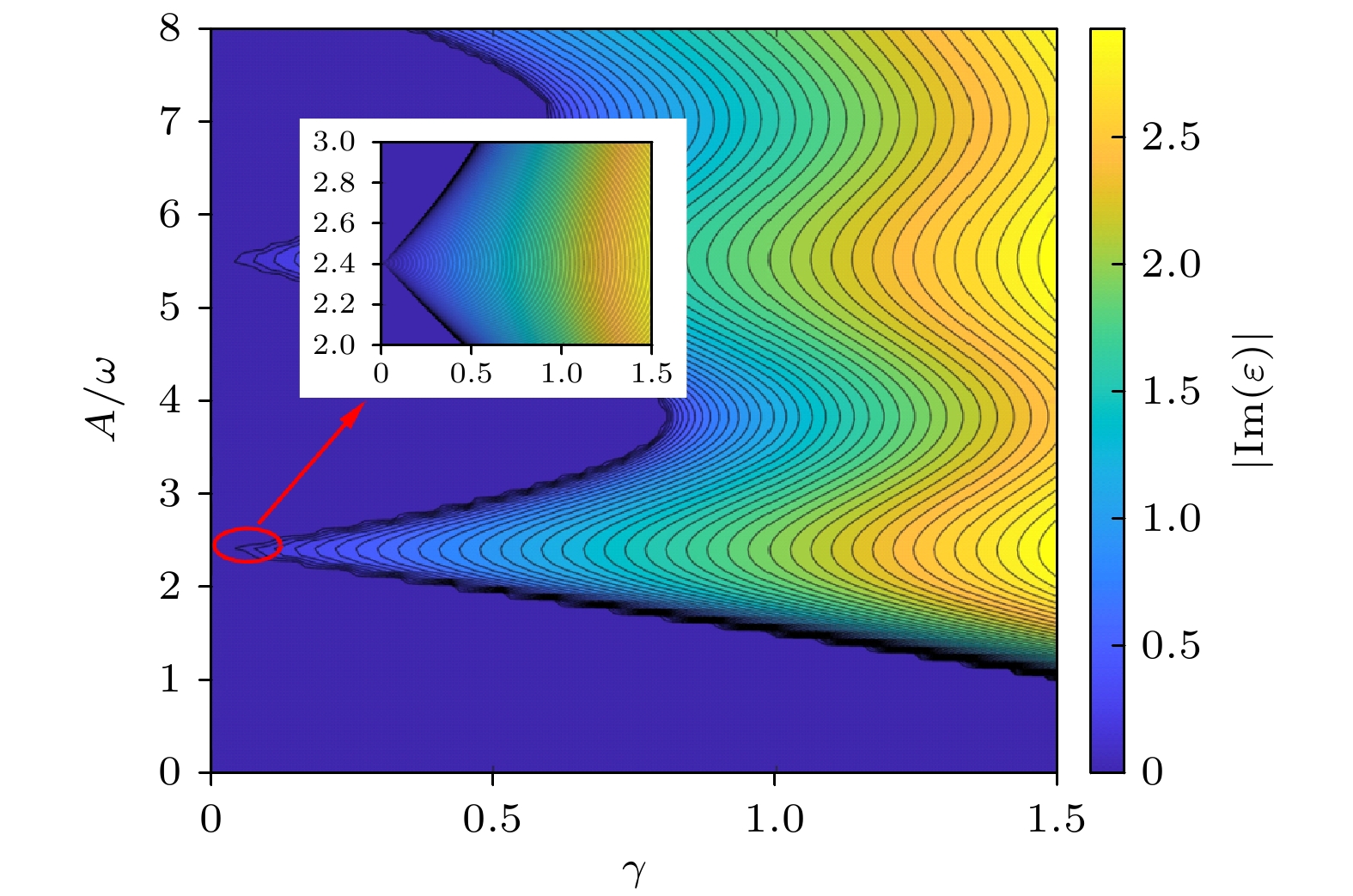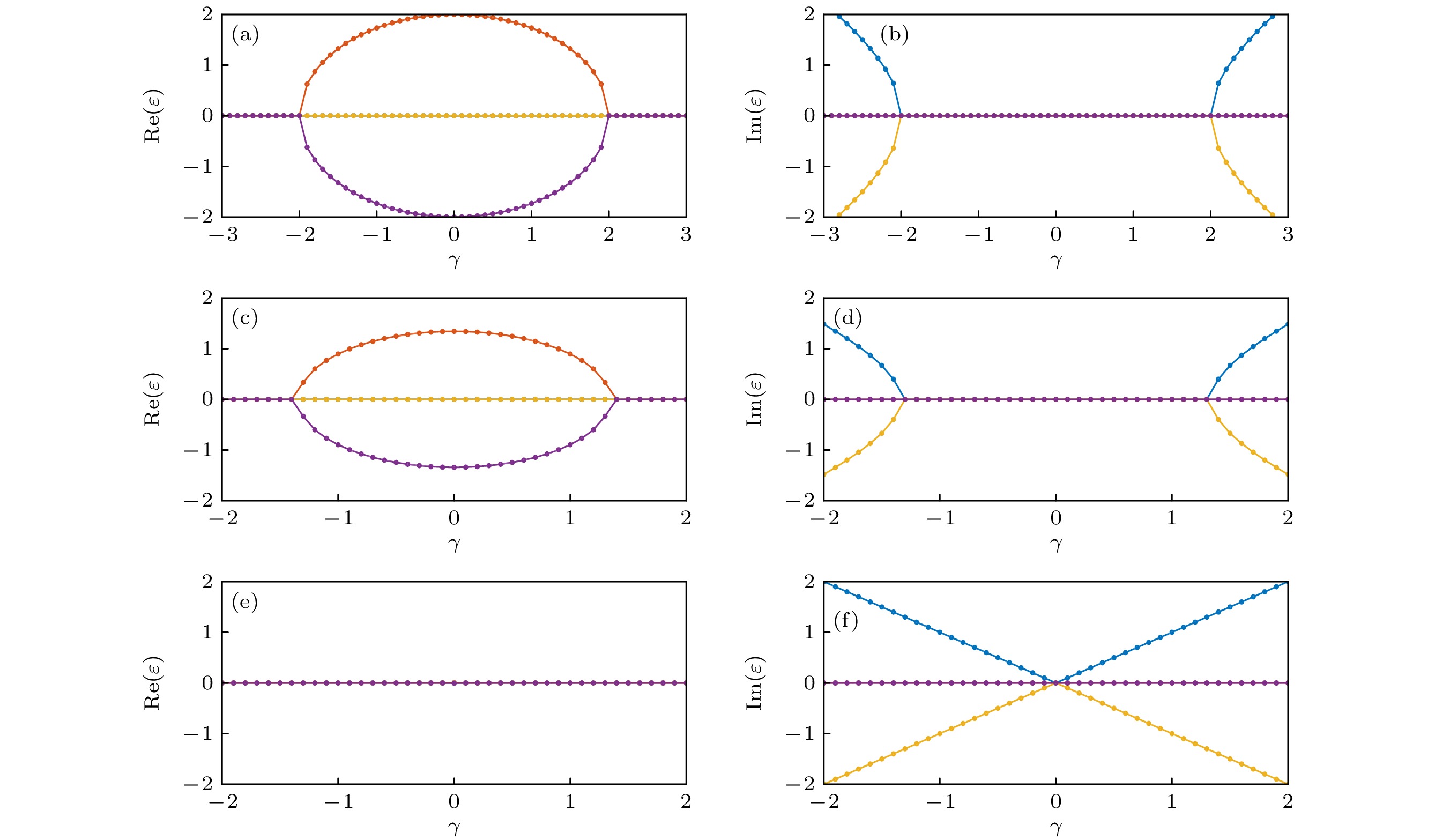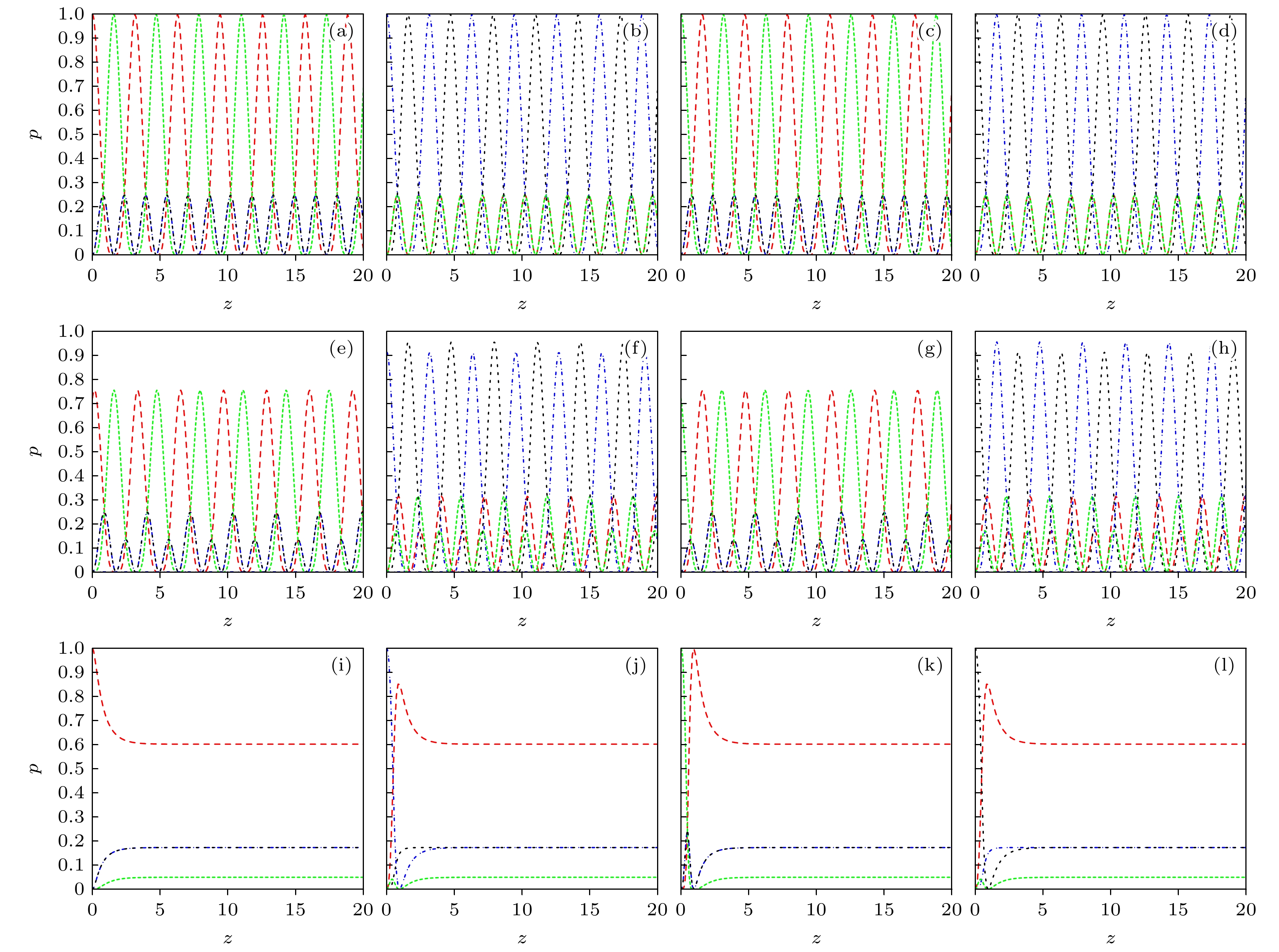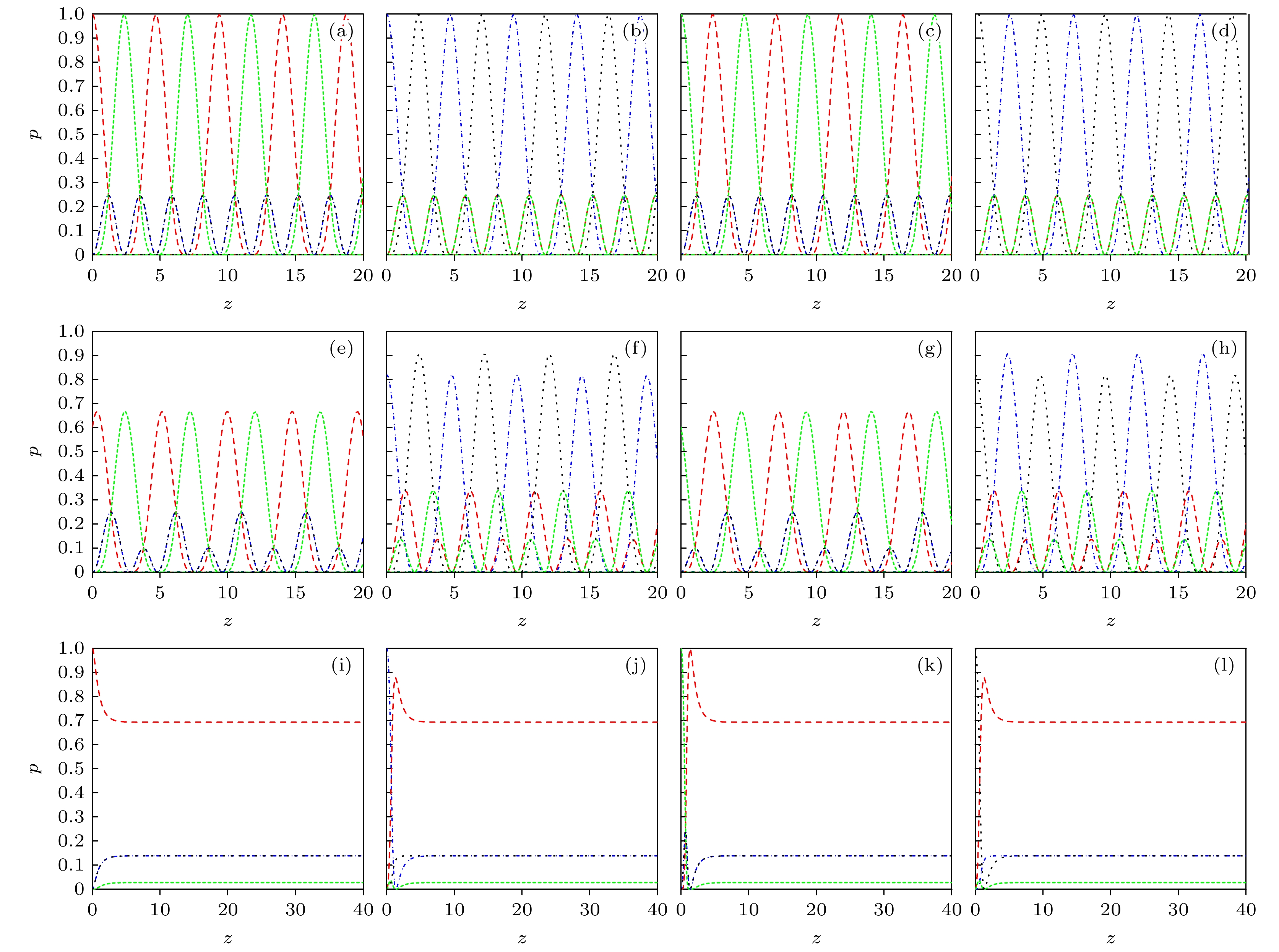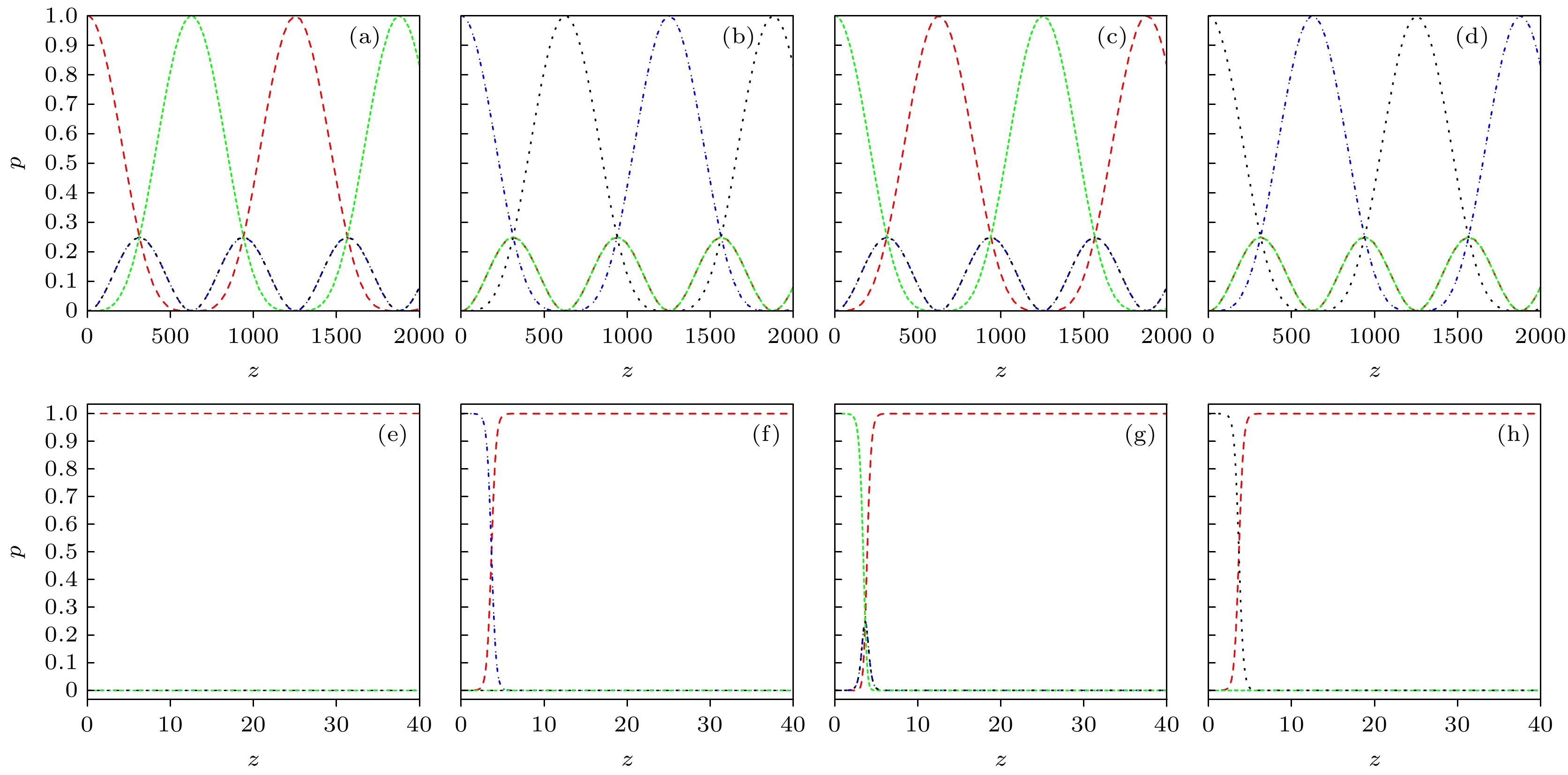-
光学系统中周期调制主要是通过周期性变化的复折射率材料来实现, 类似于周期驱动系统的量子隧穿行为, 宇称-时间(PT)对称光学波导系统中光的传播可以通过周期调制来进行有效操控. 本文设计了一种通过周期调制波导与增益型-耗散型波导交叉放置调控PT对称性的物理模型, 在高频近似下讨论了周期调制对体系能谱的影响, 最后结合解析和数值的方法揭示了光在非厄米四通道光学波导中的动力学演化. 结果表明, 与以往周期调制波导与增益型-耗散型波导平行放置的四通道光学波导体系相比, 不仅可以通过周期调制调窄完全实能谱的存在范围, 且可以更早地观测到实能谱. 此外, 调制参数变化时, 四通道波导的相对光强和光学周期更为稳定. 该理论研究给出了一种更为高效、稳定的调控PT对称的构型.The control of parity-time (PT) symmetry in cosmic-time PT symmetry system is of great significance, but the experimental realization of such an optical configuration using current technology faces enormous challenges. On the contrary, the periodic modulation method is a more feasible alternative. It is worth noting that periodic modulation in optical system is mainly performed through the cyclic change of complex refractive index materials. Unlike the traditional method of aligning periodically modulated waveguides in parallel to gain-dissipative waveguides to satisfy PT symmetry, an innovative physical model introduced in this work, features the cross-placement of these waveguides, marking it the first instance to use this configuration to manipulate PT symmetry. In this work, the influence of periodic modulation on the energy spectrum of the system in the high-frequency approximation is studied, and the dynamical evolution of light in a non-Hermitian four-channel optical waveguide is elucidated through a synergistic method of combining analytical method and numerical method. Adjusting the modulation parameter A/ω reveals a dual capability: it modulates the range of the real energy spectrum and precisely controls the PT symmetry of the system. Notably, at A/ω = 0, this structure exhibits a completely real energy spectrum, which is different from the traditional parallel four-channel waveguide configuration. Furthermore, as A/ω varies from 0 to 2.4, the relative intensity and optical periodicity in each waveguide exhibit enhanced stability compared with their traditionally arranged counterparts. Furthermore, our examination of PT symmetry’s effect on light tunneling dynamics in individual waveguide reveals that in the unbroken PT symmetry phase, light oscillates periodically between waveguides, whereas in the broken PT symmetry phase, light propagation in each waveguide becomes stable. In the presence of waveguide coupling, it is observed that each waveguide in the system can obtain steady-state light regardless of the initial light injection point. Furthermore, under weak coupling between the gain-dissipative two-channel waveguide and the neutral waveguide, light, regardless of its entry point, will localize in the gain waveguide with propagation distance, disappear from other waveguides, and ultimately reach a steady-state configuration. The findings reveal that unlike the scenario of traditional four-channel optical waveguide system, the periodic modulation not only narrows the range of existence for the fully real energy spectrum but also enables its earlier observation. Furthermore, the relative light intensity and optical periodicity in the four-channel waveguide exhibit greater stability against variations of modulation parameters. Hence, this theoretical exploration not only profoundly summarizes the universal principle of PT-symmetric tetramers, but also elucidates that spontaneous PT symmetry breaking greatly changes the optical transmission characteristics, transforming periodic light propagation into steady-state illumination, and providing an enhanced and more robust configuration for the manipulation of PT symmetry.
-
Keywords:
- parity-time symmetry /
- periodic modulation /
- four-channel waveguide
[1] Bender C M, Boettcher S 1998 Phys. Rev. Lett. 80 5243
 Google Scholar
Google Scholar
[2] Long Y, Xue H R, Zhang B L 2022 Phys. Rev. B 105 L100102
 Google Scholar
Google Scholar
[3] Bender C M 2007 Rep. Prog. Phys. 70 947
 Google Scholar
Google Scholar
[4] Xia S Q, Kaltsas D, Song D H, Komis I, Xu J J, Szameit A, Buljan H, Makris K G, Chen Z G 2021 Science 372 72
 Google Scholar
Google Scholar
[5] Moiseyev N 2011 Non-Hermitian Quantum Mechanics (Cambridge: Cambridge University Press) p211
[6] Witoński P, Mossakowska-Wyszyńska A, Szczepański P 2023 Crystals 13 258
 Google Scholar
Google Scholar
[7] Li H J, Jia Q W, Lü B, Cao F Z, Yang G X, Liu D H, Shi J W 2023 Opt. Express 31 14986
 Google Scholar
Google Scholar
[8] Şeker E, Olyaeefar B, Dadashi K, Şengül S, Teimourpour M H, El-Ganainy R, Demir A 2023 Sci. Appl. 12 149
[9] 付林雪, 范孟军, 丁亚琼, 付新铭 2023 应用物理 13 183
 Google Scholar
Google Scholar
Fu L X, Fan M J, Ding Y Q, Fu X M 2023 Appl. Phys. 13 183
 Google Scholar
Google Scholar
[10] Yao S Y, Wang Z 2018 Phys. Rev. Lett. 121 086803
 Google Scholar
Google Scholar
[11] Ke S L, Wen W T, Zhao D, Wang Y 2023 Phys. Rev. A 107 053508
 Google Scholar
Google Scholar
[12] Zhu W W, Gong J B 2023 Phys. Rev. B 108 035406
 Google Scholar
Google Scholar
[13] Tang W Y, Ding K, Ma G C 2021 Phys. Rev. Lett. 127 034301
 Google Scholar
Google Scholar
[14] Parkavi J R, Chandrasekar V K, Lakshmanan M 2021 Phys. Rev. A 103 023721
 Google Scholar
Google Scholar
[15] 郭志伟, 陈鸿 2024 物理 53 33
 Google Scholar
Google Scholar
Guo Z W, Chen H 2024 Physics 53 33
 Google Scholar
Google Scholar
[16] El-Ganainy R, Makris K G, Khajavikhan M, Musslimani Z H, Rotter S, Christodoulides D N 2018 Nat. Phys. 14 11
 Google Scholar
Google Scholar
[17] Morfonios C V, Kalozoumis P A, Diakonos F K, Schmelcher P 2017 Ann. Phys. 385 623
 Google Scholar
Google Scholar
[18] 王洪飞, 解碧野, 詹鹏, 卢明辉, 陈延峰 2019 物理学报 68 224206
 Google Scholar
Google Scholar
Wang H F, Xie B Y, Zhan P, Lu M H, Chen Y F 2019 Acta Phys. Sin. 68 224206
 Google Scholar
Google Scholar
[19] Jin L 2018 Phys. Rev. A 98 022117
 Google Scholar
Google Scholar
[20] Xu H S, Jin L 2021 Phys. Rev. A 104 012218
 Google Scholar
Google Scholar
[21] Parto M, Wittek S, Hodaei H, Harari G, Bandres M A, Ren J H, Rechtsman M C, Segev M, Christodoulides D N, Khajavikhan M 2018 Phys. Rev. Lett. 120 113901
 Google Scholar
Google Scholar
[22] Ge L, Türeci H E 2013 Phys. Rev. A 88 53810
 Google Scholar
Google Scholar
[23] Zhang J, Feng Z, Sun X 2022 arXiv. 2201 00948 [physics.optics]
[24] 柴若衡, 刘文玮, 程化, 田建国, 陈树琪 2021 光学学报 41 0123001
 Google Scholar
Google Scholar
Cai R H, Liu W W, Chen H, Tian J G, Chen S Q 2021 Acta Opt. Sin. 41 0123001
 Google Scholar
Google Scholar
[25] Longhi S 2009 Phys. Rev. Lett. 103 123601
 Google Scholar
Google Scholar
[26] Klaiman S, Günther U, Moiseyev N 2008 Phys. Rev. Lett. 101 080402
 Google Scholar
Google Scholar
[27] Rüter C E, Makris K G, El-Ganainy R, Christodoulides D N, Segev M, Kip D 2010 Nat. Phys. 6 192
 Google Scholar
Google Scholar
[28] 曲登科, 范毅, 薛鹏 2022 物理学报 71 130301
 Google Scholar
Google Scholar
Qu D K, Fan Y, Xue P 2022 Acta. Phys. Sin. 71 130301
 Google Scholar
Google Scholar
[29] Feng L, Wong Z J, Ma R M, Wang Y, Zhang X 2014 Science 346 972
 Google Scholar
Google Scholar
[30] Miao P, Zhang Z F, Sun J B, Walasik W, Longhi S, Litchinitser N M, Feng L 2016 Science 353 464
 Google Scholar
Google Scholar
[31] Zhu B, Zhong H H, Jia J, Ye F Q, Fu L B 2020 Phys. Rev. A 102 053510
 Google Scholar
Google Scholar
[32] Morandotti R, Peschel U, Aitchison J S, Eisenberg H S, Silberberg Y 1999 Phys. Rev. Lett. 83 4756
 Google Scholar
Google Scholar
[33] Trompeter H, Pertsch T, Lederer F, Michaelis D, Streppel U, Bräuer A, Peschel U 2006 Phys. Rev. Lett. 96 023901
 Google Scholar
Google Scholar
[34] Trompeter H, Krolikowski W, Neshev D N, Desyatnikov A S, Sukhorukov A A, Kivshar Y S, Lederer F 2006 Phys. Rev. Lett. 96 053903
 Google Scholar
Google Scholar
[35] 朱博 2016 硕士学位论文 (吉首: 吉首大学)
Zhu B 2016 M. S. Thesis (Jishou: Jishou University
-
图 1 理论模型示意图. G和L分别为增益波导和耗散波导, P为周期调制的中性波导, a和b分别代表不同光波导之间的耦合强度
Fig. 1. Schematic illustration of the theoretical framework depicts gain (G) and dissipation (L) waveguides, alongside periodically modulated neutral waveguides (P), the coupling strengths between these optical waveguides are denoted by symbols a and b, respectively.
图 3 对于不同的驱动振幅A, 准能谱随非厄米参数γ的变化, 其中驱动频率ω = 10, 实线表示高频近似下的解析解, 圆圈表示由哈密顿量(2)式求得的数值解 (a), (b) A/ω = 0; (c), (d) A/ω = 1.2; (e), (f) A/ω = 2.4
Fig. 3. For varying driving amplitudes (A), the quasi-energy spectrum undergoes modifications in response to the non-Hermitian parameter (γ), with the driving frequency fixed at (ω = 10), the analytical solution under the high-frequency approximation is represented by solid lines, while the numerical solution derived from Hamiltonian Eq. (2) is depicted by circles: (a), (b) A/ω = 0; (c), (d) A/ω = 1.2; (e), (f) A/ω = 2.4.
图 4 当调制参数$ A/\omega = 0 $, 系统处于厄米($ \gamma = 0 $, (a)—(d))、非厄米(实准能量, $ \gamma = 0.3 $ (e)—(h))和非厄米(复准能量, $ \gamma = $$ 2.4 $, (i)—(l))状态时光从不同的波导入射后光在波导中的隧穿情况. 第1列表示光从增益波导入射; 第2列和第4列表示光从周期调制的中性波导入射; 第3列表示光从耗散波导入射. 其中增益波导中的相对光强用红色表示, 两根中性波导中的相对光强分别用蓝色、黑色表示, 耗散波导中的相对光强用绿色表示, 其他参数选择$ a = b = 1 $, $ \omega = 10 $
Fig. 4. At a modulation parameter of (A/ω = 0), the system exhibits a unique configuration encompassing Hermitian ($ \gamma = 0 $, (a)–(d)), non-Hermitian with real reference energy ($ \gamma = 0.3 $, (e)–(h)), and non-Hermitian with complex quasi-energy ($ \gamma = 2.4 $, (i)–(l)) states. The configuration of light sources is specified as follows: the first column corresponds to light injection from the gain wave, the second and fourth columns signify light introduction from a periodically modulated neutral wave, and the third column represents light injected from the dissipative wave. The relative intensities of light are distinguished by color: red for the gain waveguide, blue and black for the two neutral waveguides, and green for the dissipative waveguide. For the remaining parameters, a = b = 1 and ω = 10.
图 5 当调制参数$ A/\omega = 1.2 $, 系统处于厄米($ \gamma = 0 $, (a)—(d))、非厄米(实准能量, $ \gamma = 0.3 $, (e)—(h))和非厄米(复准能量, $ \gamma = 1.8 $, (i)—(l))状态时光从不同的波导入射后光在波导中的隧穿情况, 第1列表示光从增益波导入射; 第2列和第4列表示光从周期调制的中性波导入射; 第3列表示光从耗散波导入射, 其中增益波导中的相对光强用红色表示, 两根中性波导中的相对光强分别用蓝色、黑色表示, 耗散波导中的相对光强用绿色表示, 其他参数选择$ a = b = 1 $, $ \omega = 10 $
Fig. 5. At a modulation parameter (A/ω = 1.2), the system manifests in three distinct states: Hermitian ($ \gamma = 0 $, (a)–(d)), non-Hermitian with real reference energy ($ \gamma = 0.3 $, (e)–(h)), and non-Hermitian with complex quasi-energy ($ \gamma = 1.8 $, (i)–(l)). The source configuration is consistent, with the first column depicting light injection from the gain wave, the second and fourth columns signifying light introduction from a periodically modulated neutral wave, and the third column representing light injection from the dissipative wave. The relative intensities of light are represented by distinct colors: red for the gain waveguide, blue and black for the two neutral waveguides, and green for the dissipative waveguide. For the remaining parameters, a = b = 1 and ω = 10.
图 6 当调制参数$ A/\omega = 2.4 $, 系统处于厄米($ \gamma = 0 $, (a)—(d))和非厄米(复准能量, $ \gamma = 1.8 $, (e)—(h))状态时光从不同的波导入射后光在波导中的隧穿情况, 第1列表示光从增益波导入射; 第2列和第4列表示光从周期调制的中性波导入射; 第3列表示光从耗散波导入射, 其中增益波导中的相对光强用红色表示, 两根中性波导中的相对光强分别用蓝色、黑色表示, 耗散波导中的相对光强用绿色表示, 其他参数选择$ a = b = 1 $, $ \omega = 10 $
Fig. 6. At a modulation parameter of (A/ω = 2.4), the system assumes both Hermitian (γ = 0, (a)–(d)) and non-Hermitian (complex quasi-energy, γ = 1.8, (e)–(h)) states. The arrangement of light sources is as follows: the first column signifies light injection from the gain wave; the second and fourth columns represent light introduction from a periodically modulated neutral wave; whereas the third column denotes light injection from the dissipative wave. The relative intensities of light are color-coded: red for the gain waveguide, blue and black for the two neutral waveguides, and green for the dissipative waveguide. For the remaining parameters, a = b = 1 and ω = 10.
-
[1] Bender C M, Boettcher S 1998 Phys. Rev. Lett. 80 5243
 Google Scholar
Google Scholar
[2] Long Y, Xue H R, Zhang B L 2022 Phys. Rev. B 105 L100102
 Google Scholar
Google Scholar
[3] Bender C M 2007 Rep. Prog. Phys. 70 947
 Google Scholar
Google Scholar
[4] Xia S Q, Kaltsas D, Song D H, Komis I, Xu J J, Szameit A, Buljan H, Makris K G, Chen Z G 2021 Science 372 72
 Google Scholar
Google Scholar
[5] Moiseyev N 2011 Non-Hermitian Quantum Mechanics (Cambridge: Cambridge University Press) p211
[6] Witoński P, Mossakowska-Wyszyńska A, Szczepański P 2023 Crystals 13 258
 Google Scholar
Google Scholar
[7] Li H J, Jia Q W, Lü B, Cao F Z, Yang G X, Liu D H, Shi J W 2023 Opt. Express 31 14986
 Google Scholar
Google Scholar
[8] Şeker E, Olyaeefar B, Dadashi K, Şengül S, Teimourpour M H, El-Ganainy R, Demir A 2023 Sci. Appl. 12 149
[9] 付林雪, 范孟军, 丁亚琼, 付新铭 2023 应用物理 13 183
 Google Scholar
Google Scholar
Fu L X, Fan M J, Ding Y Q, Fu X M 2023 Appl. Phys. 13 183
 Google Scholar
Google Scholar
[10] Yao S Y, Wang Z 2018 Phys. Rev. Lett. 121 086803
 Google Scholar
Google Scholar
[11] Ke S L, Wen W T, Zhao D, Wang Y 2023 Phys. Rev. A 107 053508
 Google Scholar
Google Scholar
[12] Zhu W W, Gong J B 2023 Phys. Rev. B 108 035406
 Google Scholar
Google Scholar
[13] Tang W Y, Ding K, Ma G C 2021 Phys. Rev. Lett. 127 034301
 Google Scholar
Google Scholar
[14] Parkavi J R, Chandrasekar V K, Lakshmanan M 2021 Phys. Rev. A 103 023721
 Google Scholar
Google Scholar
[15] 郭志伟, 陈鸿 2024 物理 53 33
 Google Scholar
Google Scholar
Guo Z W, Chen H 2024 Physics 53 33
 Google Scholar
Google Scholar
[16] El-Ganainy R, Makris K G, Khajavikhan M, Musslimani Z H, Rotter S, Christodoulides D N 2018 Nat. Phys. 14 11
 Google Scholar
Google Scholar
[17] Morfonios C V, Kalozoumis P A, Diakonos F K, Schmelcher P 2017 Ann. Phys. 385 623
 Google Scholar
Google Scholar
[18] 王洪飞, 解碧野, 詹鹏, 卢明辉, 陈延峰 2019 物理学报 68 224206
 Google Scholar
Google Scholar
Wang H F, Xie B Y, Zhan P, Lu M H, Chen Y F 2019 Acta Phys. Sin. 68 224206
 Google Scholar
Google Scholar
[19] Jin L 2018 Phys. Rev. A 98 022117
 Google Scholar
Google Scholar
[20] Xu H S, Jin L 2021 Phys. Rev. A 104 012218
 Google Scholar
Google Scholar
[21] Parto M, Wittek S, Hodaei H, Harari G, Bandres M A, Ren J H, Rechtsman M C, Segev M, Christodoulides D N, Khajavikhan M 2018 Phys. Rev. Lett. 120 113901
 Google Scholar
Google Scholar
[22] Ge L, Türeci H E 2013 Phys. Rev. A 88 53810
 Google Scholar
Google Scholar
[23] Zhang J, Feng Z, Sun X 2022 arXiv. 2201 00948 [physics.optics]
[24] 柴若衡, 刘文玮, 程化, 田建国, 陈树琪 2021 光学学报 41 0123001
 Google Scholar
Google Scholar
Cai R H, Liu W W, Chen H, Tian J G, Chen S Q 2021 Acta Opt. Sin. 41 0123001
 Google Scholar
Google Scholar
[25] Longhi S 2009 Phys. Rev. Lett. 103 123601
 Google Scholar
Google Scholar
[26] Klaiman S, Günther U, Moiseyev N 2008 Phys. Rev. Lett. 101 080402
 Google Scholar
Google Scholar
[27] Rüter C E, Makris K G, El-Ganainy R, Christodoulides D N, Segev M, Kip D 2010 Nat. Phys. 6 192
 Google Scholar
Google Scholar
[28] 曲登科, 范毅, 薛鹏 2022 物理学报 71 130301
 Google Scholar
Google Scholar
Qu D K, Fan Y, Xue P 2022 Acta. Phys. Sin. 71 130301
 Google Scholar
Google Scholar
[29] Feng L, Wong Z J, Ma R M, Wang Y, Zhang X 2014 Science 346 972
 Google Scholar
Google Scholar
[30] Miao P, Zhang Z F, Sun J B, Walasik W, Longhi S, Litchinitser N M, Feng L 2016 Science 353 464
 Google Scholar
Google Scholar
[31] Zhu B, Zhong H H, Jia J, Ye F Q, Fu L B 2020 Phys. Rev. A 102 053510
 Google Scholar
Google Scholar
[32] Morandotti R, Peschel U, Aitchison J S, Eisenberg H S, Silberberg Y 1999 Phys. Rev. Lett. 83 4756
 Google Scholar
Google Scholar
[33] Trompeter H, Pertsch T, Lederer F, Michaelis D, Streppel U, Bräuer A, Peschel U 2006 Phys. Rev. Lett. 96 023901
 Google Scholar
Google Scholar
[34] Trompeter H, Krolikowski W, Neshev D N, Desyatnikov A S, Sukhorukov A A, Kivshar Y S, Lederer F 2006 Phys. Rev. Lett. 96 053903
 Google Scholar
Google Scholar
[35] 朱博 2016 硕士学位论文 (吉首: 吉首大学)
Zhu B 2016 M. S. Thesis (Jishou: Jishou University
计量
- 文章访问数: 3513
- PDF下载量: 230
- 被引次数: 0













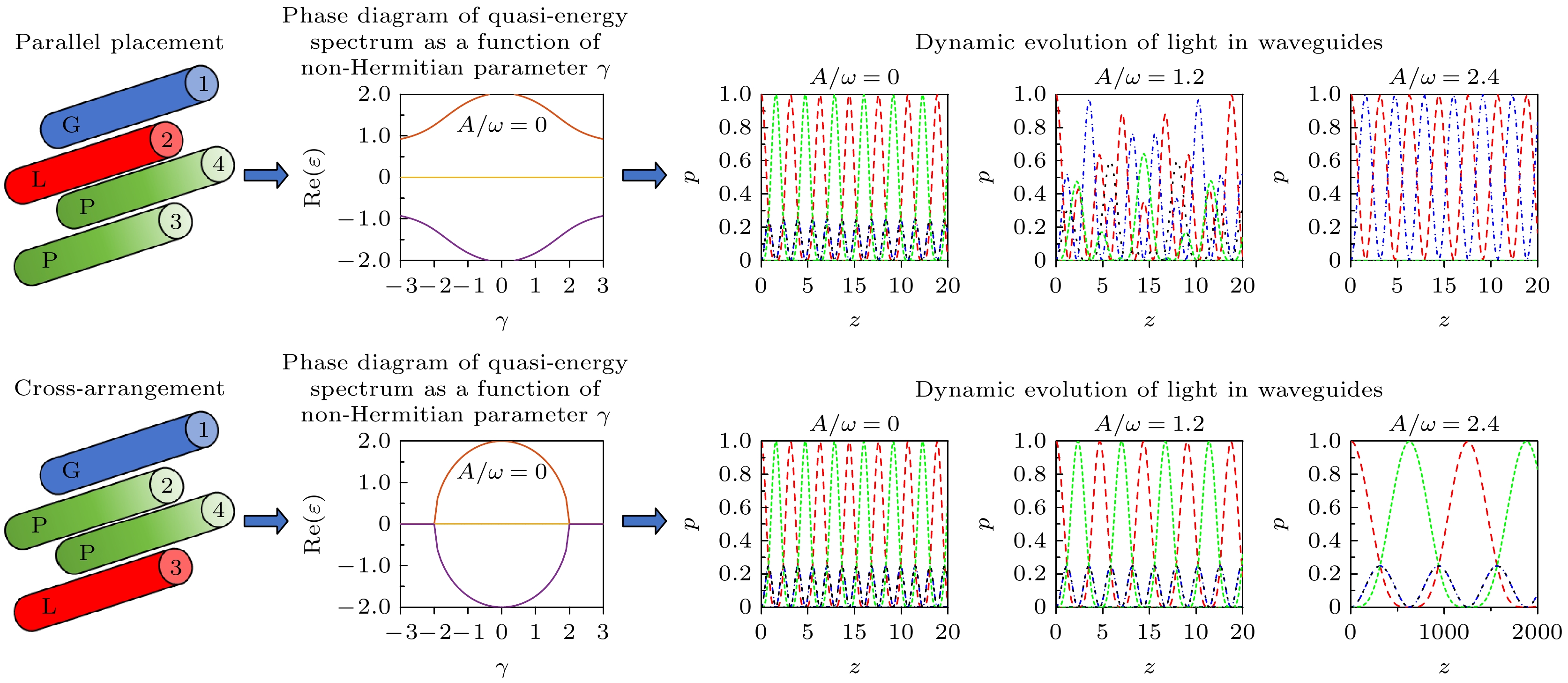
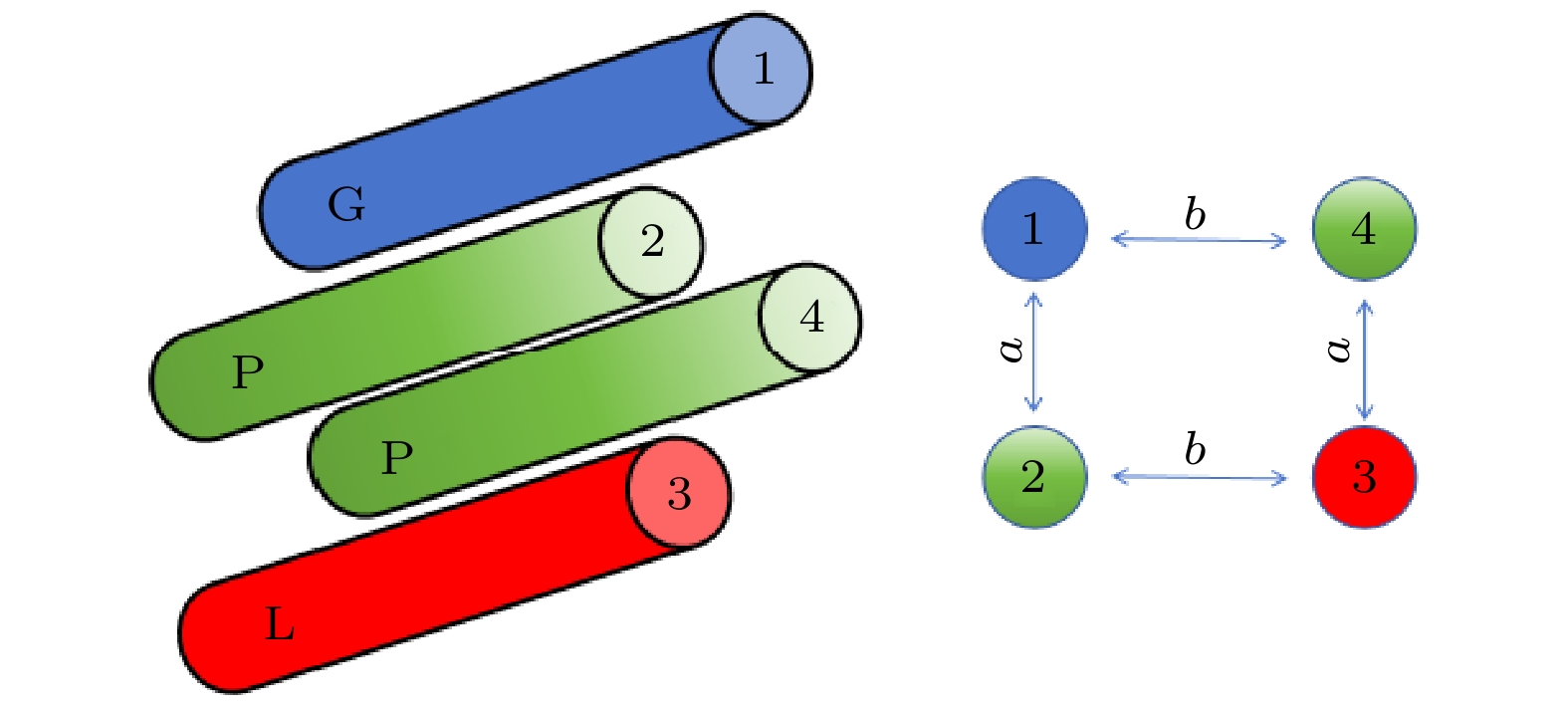
 下载:
下载:
